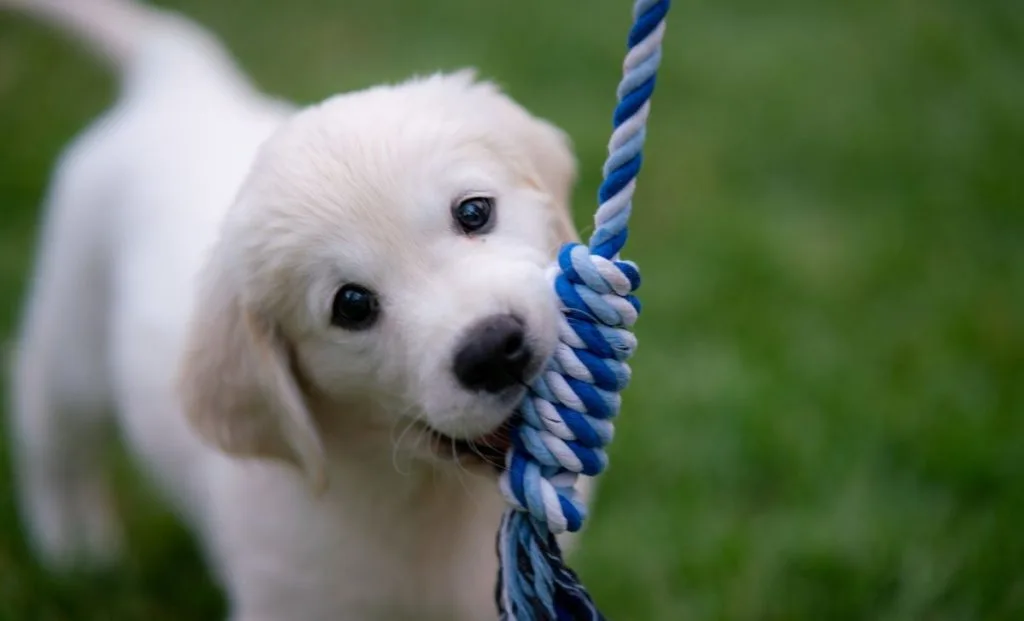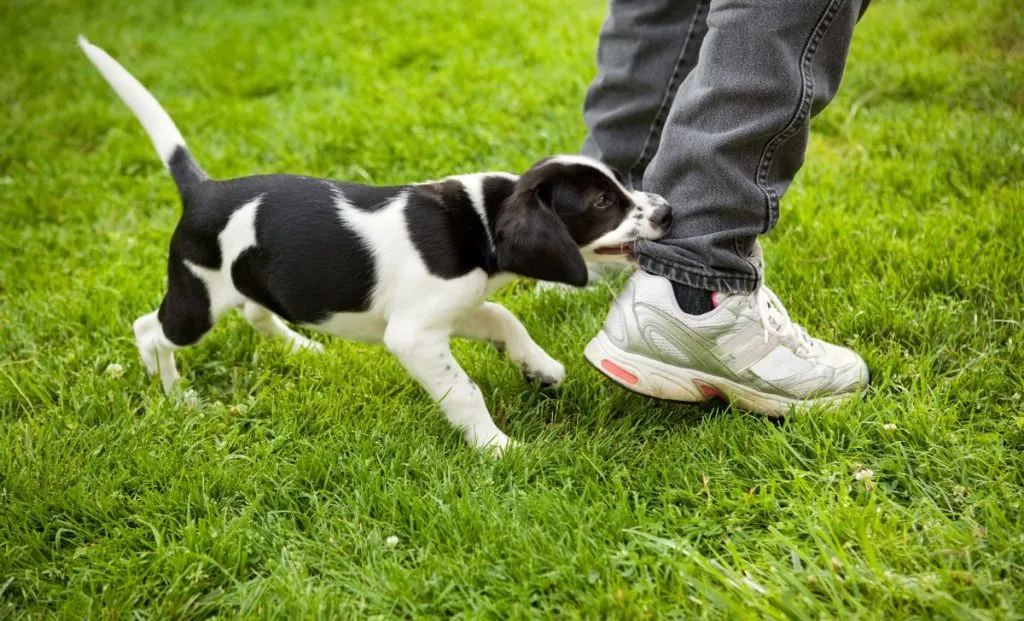Bringing home a new puppy is super exciting, but figuring out how to stop a puppy from crying can be a bit overwhelming. If you’re hearing those heart-wrenching puppy cries all day and night, don’t worry — you’re not alone!
New pet parents everywhere face this challenge, and it’s important to understand why your adorable pup might be feeling so unsettled.
Wondering if it is OK to ignore a crying puppy? Curious about how crates, comfy spots, and playpens can help?
We’ve got all sorts of ways to make your furry friend feel secure, from a gradual introduction to their new home to making sure they get lots of love and the right amount of playtime.
7 Immediate Solutions On How Stop A Puppy From Crying

First off, let’s acknowledge that puppy screams and cries are totally normal behavior, especially in those early days.
Whining is a normal part of puppyhood. Just like human babies, puppies use whining to communicate their needs and feelings. It’s their way of saying, “Hey, I need something!”
Our job is to show them that they’re safe and surrounded by lots of love.
These following options will have your pupper smiling instead of crying!
1. Check Basic Needs

Alright, new pet parents, let’s start with the basics! Imagine you’re a tiny, new puppy in a big, unfamiliar world.
Those heart-wrenching puppy cries can often mean your pup needs something simple.
So, the first step is to ask yourself: ”Is our little friend hungry or thirsty?” Just like us, they get cranky if they miss meal time.
Always make sure they have fresh water and enough food throughout the day.
Now, let’s talk comfort. A cozy spot is crucial!
It can be a comfy blanket or a snuggly bed, but make sure that it is a snuggly place where they can feel secure because it really makes a big difference.
Check for loud noises too — your new dog might be startled by unfamiliar sounds. Creating a peaceful environment can help soothe those initial cries.
2. Create A Safe Space
Next up, let’s build the ultimate pup comfort zone.
This should be like a pupper’s sanctuary, a place where they can feel completely safe.
Crates can be a great idea if used correctly. Fill it with their favorite toys and soft bedding to make it inviting. It’s not just a place for them to sleep, but a haven where they can retreat when they’re feeling overwhelmed.
Remember to choose a quiet corner of your home away from the hustle and bustle. This could be a cozy nook in your living room or a spare bedroom. Avoid areas with loud noises like the kitchen or the TV or a busy hallway.
Also avoid placing the crate in rooms that are near loud outdoor areas such as building sites or busy roads.
If you’re not a fan of crates, a playpen is another great option. It gives your puppy some space to move around while still feeling secure.
Fill it with comfortable places to rest and a few of their favorite toys to keep them entertained.
You know you’ve done a good job creating a safe area when you watch them circling before they lay down and fall asleep.
3. Gradual Introduction To Alone Time

We know those initial cries can be tough to hear, but with a little patience, your pup will learn that alone time isn’t so bad after all. A very important step in stopping or preventing a puppy from crying is a gradual introduction.
Start by leaving your puppy alone for very short periods — just a few minutes at a time. Make sure they’re in their safe space with all their comforts around them.
Introduce some favourite toys into the mix; these can be a lifesaver! These can be chew toys, squeaky toys or treat toys. Not only do they keep your pup entertained, but the familiar sounds and textures can be a source of comfort when you’re not around.
Gradually increase the time you spend away, making sure to stay calm and not make a big deal out of your departures and returns.
This teaches your puppy that it’s normal for you to come and go, and they’ll learn to trust that you’ll always come back.
Another great tip is to give them a special treat or a new toy that they only get during alone time. This creates a positive association with being by themselves.
Remember, the goal is to build their confidence and help them understand that alone time can be fun and relaxing, not scary.
4. Use Calming Aids
When it comes to soothing a crying puppy, calming aids can be incredibly effective.
These tools are designed to create a relaxing environment for your little furball, helping to reduce anxiety and stress.
For example, Dog Appeasing Pheromone has been found to help puppies settle into new homes by reducing crying and disturbance at night.
This effect is particularly significant in certain breeds, such as gundogs, where puppies treated with DAP cried significantly less (1).
DAP mimics the comforting pheromones that a mother dog naturally produces, creating a sense of security and calm for the puppy.
You can find it in various forms, such as diffusers, sprays, and collars, making it easy to use in different settings.
Another calming aid to consider is a heartbeat toy. These toys replicate the sound and feel of a mother’s heartbeat, providing comfort to puppies who are missing the close presence of their littermates and mother.
Placing a heartbeat toy in your puppy’s crate or playpen can help them feel less lonely and more secure.
Additionally, calming sprays and diffusers with natural ingredients like lavender and chamomile can help create a peaceful atmosphere.
These can be used around your puppy’s safe space to promote relaxation and reduce anxiety.
When introducing these aids, it’s important to monitor your puppy’s reaction to make sure that they are comfortable and not stressed by the new sensations.
5. Provide Enough Exercise

Ensuring our new puppy gets plenty of exercise is one of the best ways to help them settle in and reduce those heart-wrenching puppy cries.
Dog lead training is a great first step. We are not just about burning energy, but we are also teaching our puppies how to walk nicely on a leash!
Plus, exploring the neighborhood helps them get used to all sorts of sights and sounds, from family members to building sites.
Playtime in the yard or a park with their favourite toys is another fantastic option.
It can be as simple as a game of fetch with a tennis ball. These activities provide lots of love and engagement.
And if you have other dogs or know friends with their own puppies, playdates can be a great idea to socialize and exercise your pup at the same time.
Don’t forget about indoor play though!
A playpen filled with comfortable places and stimulating toys can keep your puppy entertained and active, even when the weather isn’t cooperating.
Puzzle toys and treat dispensers can also provide mental stimulation, which is just as important as physical exercise.
6. Establish A Routine
Routines provide structure. The common trait humans and puppers have is that we are both creatures of habit and thrive on knowing what to expect and when.
Setting a routine thus helps reduce much stress for your new dog. It makes them feel more secure in their new home. Anything from meal time, playtime, or bedtime — having a set schedule can work wonders.
Time of day matters!
Start by picking consistent times of day for key activities.
Morning walks and playtime can be a fantastic way to start the day and help them burn off energy. This way, our pups are less likely to whine or cry out of boredom.
And to be honest, there’s nothing cuter than a tuckered-out pupper dreaming away after a fun day.
So, by ensuring our pups get enough physical activity, we’re not just making them happy, but also helping them (and us) get a good night’s sleep!
Evening routines are just as important. A nice walk or some gentle play before bed helps our puppies wind down and get ready for sleep.
Meal times are another crucial part of the routine.
Feeding your pup at the same times every day helps regulate their digestive system and gives them something to look forward to. Plus, it’s a great opportunity for bonding and training.
7. Comfort And Reassurance

One of the best ways to comfort a crying puppy is through physical touch.
Cuddles, gentle petting, and even just sitting close to them can make a world of difference.
If your pup is in a stressed state, a little bit of warmth and affection can go a long way in soothing their anxieties.
If your puppy stops crying after you’ve given them some attention, that’s a good sign! It means they’re starting to feel more at ease.
However, be careful not to reinforce crying by rushing to their side every time they make a peep. But, this isn’t to say that the ignore method is the right thing to do.
Is It OK To Ignore A Crying Puppy?

Spoiler alert: it’s not.
When our new puppies let out those heart-wrenching screams, they’re trying to tell us something. Ignoring them completely isn’t the best way to go about it.
First off, let’s remember that crying is a normal behavior for puppies, especially when they’re adjusting to a new home.
Sure, the ignore method might work in some training situations, but when it comes to a crying puppy, we need to be more attentive.
Giving your pup much freedom to express their needs is important. When a dog cries, they could be hungry, thirsty, or needing a bathroom break.
They might also be seeking comfort or trying to alert us to something that’s bothering them. Ignoring these cries can leave them in a stressed state, which is the last thing we want for our little furballs.
That being said, it’s a good idea to respond appropriately.
Sometimes, if we’ve ruled out all their basic needs and they’re just looking for attention, gently acknowledging them without making a big fuss can help.
This way, they know we’re there for them, but we’re not reinforcing the crying.
Over time, as they feel more secure and their behavioral needs are met, the puppy screams should reduce.
Should You Let A Puppy Cry It Out?
Nope, you shouldn’t. When those puppy screams start up, it’s usually a sign that something’s up, and our job is to figure out what our little furball needs.
Letting a puppy cry it out can lead to a stressed state and potentially make them feel insecure. Instead, try to understand why they’re crying.
Are they hungry, thirsty, or need a bathroom break? Maybe they just miss their mother or feel lonely.
By addressing these needs, we help our pups feel more comfortable and secure.
Should You Discipline A Puppy For Crying?

Our opinion: Definitely not. Disciplining a puppy for crying can be counterproductive and even harmful.
Instead of seeing it as something that needs to be disciplined, we should see it as an opportunity to understand and address their needs.
If you’ve tried all the usual tricks and your puppy still seems inconsolable, it might be worth seeking professional help.
A vet or a pet behaviorist can offer insights into any underlying issues and provide additional strategies tailored to your pupper’s specific needs.
How Long Does It Take For A Puppy To Stop Crying?
Although it might seem like a long time, typically, it takes anywhere from a few days to a few weeks for a puppy to settle in and for the crying to subside.
When you bring home a 8 to 12 weeks old puppy, they’re adjusting to a brand-new setting. They miss their mom and littermates, and everything is unfamiliar, so those puppy cries are their way of expressing that.
New pet parents have asked me a dozen of times ”Do puppies grow out of whining?” And the answer is quite simple: yes they do! But, as with all things puppy-related, it takes a bit of time, patience, and understanding of their needs.
Studies have shown that puppies’ crying is associated with physiological changes, such as increased cortisol levels, which reflect stress and emotional distress. This response is similar to how human infants and other animals react to distressing situations (2).
And just like babies, puppies will eventually grow out of this phase as they mature and become more secure in their environment.
For example, babies cry less frequently as they grow and become toddlers, learning to communicate in other ways. Similarly, as puppies grow and develop, their crying will decrease.
As our puppies grow and we meet their behavioural needs, they begin to feel more secure and confident.
This is when you’ll start to notice the whining diminish. Giving them much freedom to explore and play in a safe environment helps them feel more at ease. It’s all part of their development process.
It’s also important to note that the breed of your dog can play a role in how quickly they mature and stop crying.
Some breeds grow up and mature faster than others and thus don’t cry as much as adults. For instance, breeds like Labrador Retrievers and German Shepherds tend to mature more quickly and might stop crying sooner compared to smaller breeds like Chihuahuas or Dachshunds, which may take a bit longer to grow out of their whiny phase.
From Whines To Wags

Alright, fellow puppy parents, you’re doing an amazing job!
If you’re still trying to figure out how to stop a puppy from crying, keep in mind that it’s a journey of understanding and love.
Remember that every pup is unique, and some might take a little longer to settle in than others.
With time, care, and these supportive steps, you’ll help your puppy feel secure and loved. So, hang in there!
Before you know it, your home will be filled with the delightful sounds of a happy, well-adjusted pup.
Good luck, and may your days be filled with lots of love and wagging tails!
References
1. Taylor, K., & Mills, D. (2007). A placebo-controlled study to investigate the effect of Dog Appeasing Pheromone and other environmental and management factors on the reports of disturbance and house soiling during the night in recently adopted puppies (Canis familiaris). Applied Animal Behaviour Science, 105, 358-368. https://doi.org/10.1016/J.APPLANIM.2006.11.003.
2. Yong, M., & Ruffman, T. (2014). Emotional contagion: Dogs and humans show a similar physiological response to human infant crying. Behavioural Processes, 108, 155-165. https://doi.org/10.1016/j.beproc.2014.10.006.

Meet Iram, a devoted veterinarian, passionate dog lover, and current Ph.D. candidate at Utrecht University in the Netherlands. Seamlessly blending her roles as a vet and content writer, Iram channels her love for dogs into heartfelt narratives.
Since childhood, Iram nurtured a dream of becoming a vet, a passion that runs deep in her family. Having now fulfilled that dream, she’s eager to share her acquired knowledge. In her writing, Iram not only explores the emotional bond between humans and their canine friends but also integrates her veterinary expertise, offering readers a holistic understanding of their beloved pets.
